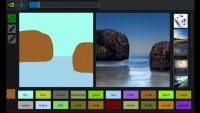Nvidia Demos New Products at Deep Learning & AI Confab
March 19, 2019
Nvidia made a number of compelling announcements at this week’s GPU Technology Conference (GTC 2019) in San Jose, California. The company unveiled its GauGAN AI image creator that uses generative adversarial networks (GANs) to turn sketches into nearly photorealistic images. As part of its cloud pursuits, the company unveiled its latest RTX server configuration that is designed for Hollywood studios and those who want to create visual content quickly (each server pod can support up to 1,280 GPUs). Nvidia also announced partnerships with 3D software makers including Adobe, Autodesk and Unity to integrate Nvidia’s RTX ray-tracing platform.
TechCrunch describes GauGAN as “MS Paint for the AI age,” pointing to the potential of Nvidia’s neural network platforms. “It’s designed to compile an image how a human would paint,” notes TechCrunch. “GauGAN has three tools: a paint bucket, pen and pencil … Select the cloud object and draw a line with the pencil, and the software will produce a wisp of photorealistic clouds.”

The app currently focuses on landscape and nature elements such as land, sea and sky, but its neural network is also capable of addressing buildings, people, roads and more.
According to Nvidia: “GauGAN could offer a powerful tool for creating virtual worlds to everyone from architects and urban planners to landscape designers and game developers. With an AI that understands how the real world looks, these professionals could better prototype ideas and make rapid changes to a synthetic scene.”
Nvidia founder and CEO Jensen Huang announced the company’s next-generation RTX server pods that feature support for “up to 1,280 Turing GPUs on 32 RTX blade servers,” reports TechCrunch. “That’s 40 GPUs per server, with each server taking up an 8U space. The GPUs here are Quadro RTX 4000 or 6000 GPUs, depending on the configuration.”

“Nvidia RTX Servers — which include fully optimized software stacks available for Optix RTX rendering, gaming, VR and AR, and professional visualization applications — can now deliver cinematic-quality graphics enhanced by ray tracing for far less than just the cost of electricity for a CPU-based rendering cluster with the same performance,” explained the company in its announcement.
Nvidia also announced new partnerships with 3D software companies that it promises will leverage its ray-tracing technology to bring new realism to gaming.
“The partnership with Unity is perhaps the most interesting,” suggests TechCrunch. “Epic Games had already announced Unreal Engine 4.22 support for Nvidia RTX ray-tracing, and it was only a matter of time before Unity made the plunge as well, but now the tech is officially coming to Unity’s High Definition Render Pipeline (HDRP) today in preview.”
The tech emphasizes “how games render lighting more realistically, showing how light interacts with the atmosphere and the objects it strikes.” “Real-time ray tracing moves real-time graphics significantly closer to realism, opening the gates to global rendering effects never before possible in the real-time domain,” explained a Unity executive.

No Comments Yet
You can be the first to comment!
Sorry, comments for this entry are closed at this time.